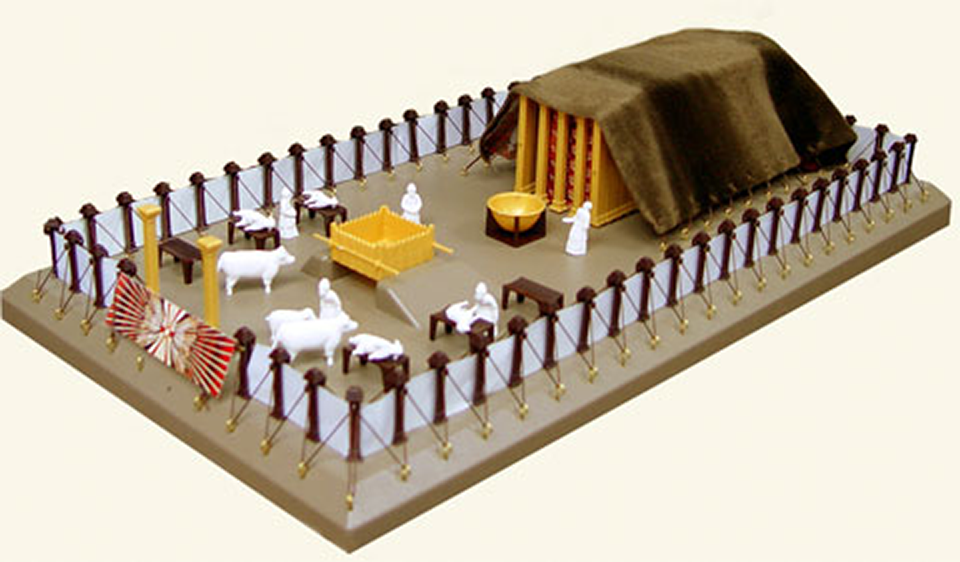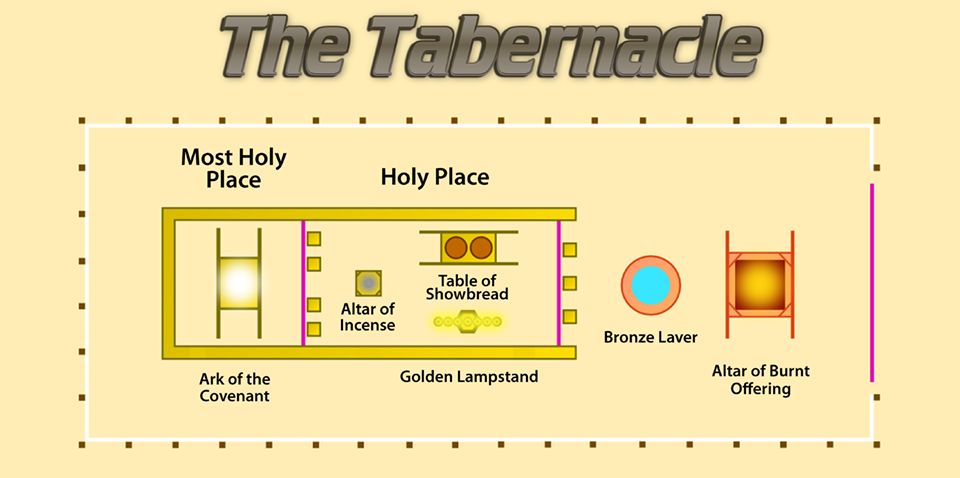
Volume 19, Issue 5 (January 29, 2017)
The Tabernacle of God
By Kyle Pope
When the children of Israel came out of Egypt the Lord commanded them to construct a tabernacle (or tent) towards which they were to worship Him. There are many things about the tabernacle that teach us about God’s nature and our relationship to Him.

The Most Holy Place
Exodus 26:30-33 tells us that the tabernacle followed a pattern that in some sense represented what exists in heaven. There were two rooms separated by a veil with a design of cherubim (angelic beings) on it. The innermost room was known as the “Most Holy Place.” The outer room was simply called the “Holy Place.” In the New Testament book of Hebrews we have a discussion regarding these two parts of the tabernacle. The text reads “Now when these things had been thus prepared the priests always went into the first part of the tabernacle, performing the services. But into the second part the high priest went alone once a year, not without blood, which he offered for himself and for the people’s sins committed in ignorance; the Holy Spirit indicating this, that the way into the Holiest of All was not yet made manifest while the first tabernacle was still standing” (Heb. 9:6-8, NKJV). We notice from this verse that the priests served regularly in the first room of the tabernacle (The Holy Place) but the inner room (The Most Holy Place) was entered only once a year by the High Priest. This demonstrates to us what could be called the “unapproachableness of God.” Not that God wants to be distant and separated from man, but His purity demands separation from sin. Isaiah 59:2 teaches that sin causes God to hide his face from human beings and to close His ears to us. Habakkuk 1:13 teaches His eyes cannot look upon wickedness nor behold evil. As a result any soul that entered His presence without having been purged of his sin would instantly die! The New Testament teaches us that Christ offers man access to the Holiest Place of God(see Heb. 9:11-12; 10:19-22).
The Ark of the Covenant. Inside the Most Holy Place was the Ark of the Covenant. It was a wooden box covered with gold. Inside it were three things: 1) The tables of testimony (the Law God had given the Israelites); 2) A pot of manna (which God had given to the Israelites to sustain them while in the wilderness); 3. Aaron’s rod that budded. On top of it was a lid of gold called the “‘mercy seat” on top of which were two cherubim with outstretched wings facing toward the mercy seat. The ark was where God met with Moses and spoke to Him from above the mercy seat. This symbolized the coming together of law and mercy.
Mercy and law (or mercy and justice) are seldom compatible). A merciful judge is seldom one who adheres strictly to the law. By the same token a strict judge is seldom thought of as merciful. How can it be that God could be both just and merciful? To understand this we must understand the dual nature of God. While Scripture teaches us that “God is love” (1 John 4:8) it also teaches us that “God is a consuming fire” (Heb. 12:29) Romans 11:22 describes this in speaking of the “goodness and severity of God.”
In Christ we see what the ark represented. Only through Christ’s death could God punish sin, yet demonstrate His mercy. Romans 3:26 tells us that God sent Christ to die that, “He might be just and the justifier of the one who has faith in Jesus.”

The Holy Place
Let us now consider the three items that were inside the Holy place: the altar of incense, the table of showbread and the golden lampstand.
1. The Altar of Incense. Exodus 40:26-27 and Hebrews 9:4 refer to the altar of incense. Many translations make it sound as if He- brews is claiming the altar was inside the Most Holy Place). There are two possible answers to this problem: 1) Some suggest that Hebrews is describing a hand held censor the priest would place before God under the curtain. 2) Others suggest that the word translated “having” in Hebrews 9:4 may communicate the idea that the altar had an association with the Most Holy Place due to the fact that the incense was offered toward the mercy seat (where the presence of God dwelt), in spite of the fact that the altar itself was in the Holy Place. Whatever the resolution, it seems that the incense was intended to represent prayers that are continually offered to God. Revelation 5:8 describes in heaven “golden bowls full of incense, which are the prayers of the saints.” This assures us our prayers are not spoken into the air, but ascend to the very throne of God like sweet smelling incense.
2. The Table of Showbread. This was a gold overlaid table on the north side of the tabernacle on which was set bread in order. This was before the Lord always. It was hallowed bread that only the priests were to eat.
3. The Golden Lampstand. This was a seven branched lampstand made of gold, on which were bowls of oil that were to be constantly trimmed and kept lit by the priests.
Although New Testament writers never specifically identity any spiritual significance these things are intended to symbolize, there may be a number of things these items represent. First, it could represent the church. The Holy Place was the section of the tabernacle where the priests were to continually carry out their service to God. The New Testament refers to the church both as the “house of God” (1 Tim. 3:15) and as a “holy priesthood” (1 Pet. 2:5). It is within our fellowship with one another in Christ’s church that we carry out our work and worship of the Lord. Second, it might be that these things represent the word of God. God’s word is both our light and our spiritual food. As priests of God Christians are to be fed continually by the light it provides and the sustenance it brings. A final possibility could be that they symbolize Christ Himself. Christ is the “living bread” (John 6:51) and the “light of the world” (John 8: 12). Those who serve Him must carry out our service feasting upon Him as living bread and following His guidance as the light guiding our every step.
The Veil
We must consider one final item that was a part of the tabernacle itself—the veil. The veil was made with a design of cherubim on it. When man was cast out of the garden cherubim were stationed to block the way to the garden and access to God (Gen. 3:24). The veil clearly represents the division between God and man that exists due to sin. Matthew 27:50-51 teaches that when Christ died the veil that was then in the temple was torn from top to bottom. Hebrews 10:20 describes this veil as Christ’s flesh. What a powerful image! One cannot go into the presence of God without going through the veil—which is Christ.
The Courtyard
Outside the tabernacle were two items of significance: the bronze laver and the altar of burnt offerings.
The Bronze Laver. Exodus 30:17-21 describes the bronze laver. This was a huge basin in which the priests were to wash themselves before entering the tabernacle. This represents cleanness before God. Only by having sins washed away can man approach God. When Ananias taught Paul what to do to become a Christian he told him in Acts 22:16 to “be baptized and wash away” his sins. Many presume to enter into the presence of God and the spiritual house of His church without first being washed.
The Altar of Burnt Offering. Exodus 40:29 tells us about the altar of burnt offerings. This would be your first sight when entering the tabernacle court. This huge altar where animals were slain and burned as a sacrifice to God represented man’s need for sacrifice when approaching God. Hebrews 9:11 teaches that Christ was the perfect offering for sin. No one may approach God—no one can worship Him acceptably without having accepted the sacrifice of God upon his or her behalf.
Have you accepted Christ’s sacrifice on your behalf? Have you been washed in His blood in the waters of baptism? Are you feeding upon the living bread? Won’t you pass through the veil of Christ into the Holiest place of God?

